TAFE NSW Assignment: Documentation and Curriculum in Early Childhood
VerifiedAdded on 2022/09/14
|15
|3359
|42
Report
AI Summary
This report provides a comprehensive overview of curriculum approaches and documentation methods suitable for early childhood education and care. It identifies jottings and anecdotal records as key documentation methods, and developmentally appropriate practice and project approach as effective curriculum approaches. The report explores the relationships between these methods and educational theories such as cognitivism, constructivism, behaviorism, and connectivism. It critiques various methods, highlighting their strengths and weaknesses, and emphasizes the importance of effective documentation and curriculum in providing high-quality early childhood education and care. The report also fulfills the requirements of the ECTPP102A Play and Documentation module, with references to key readings and texts.
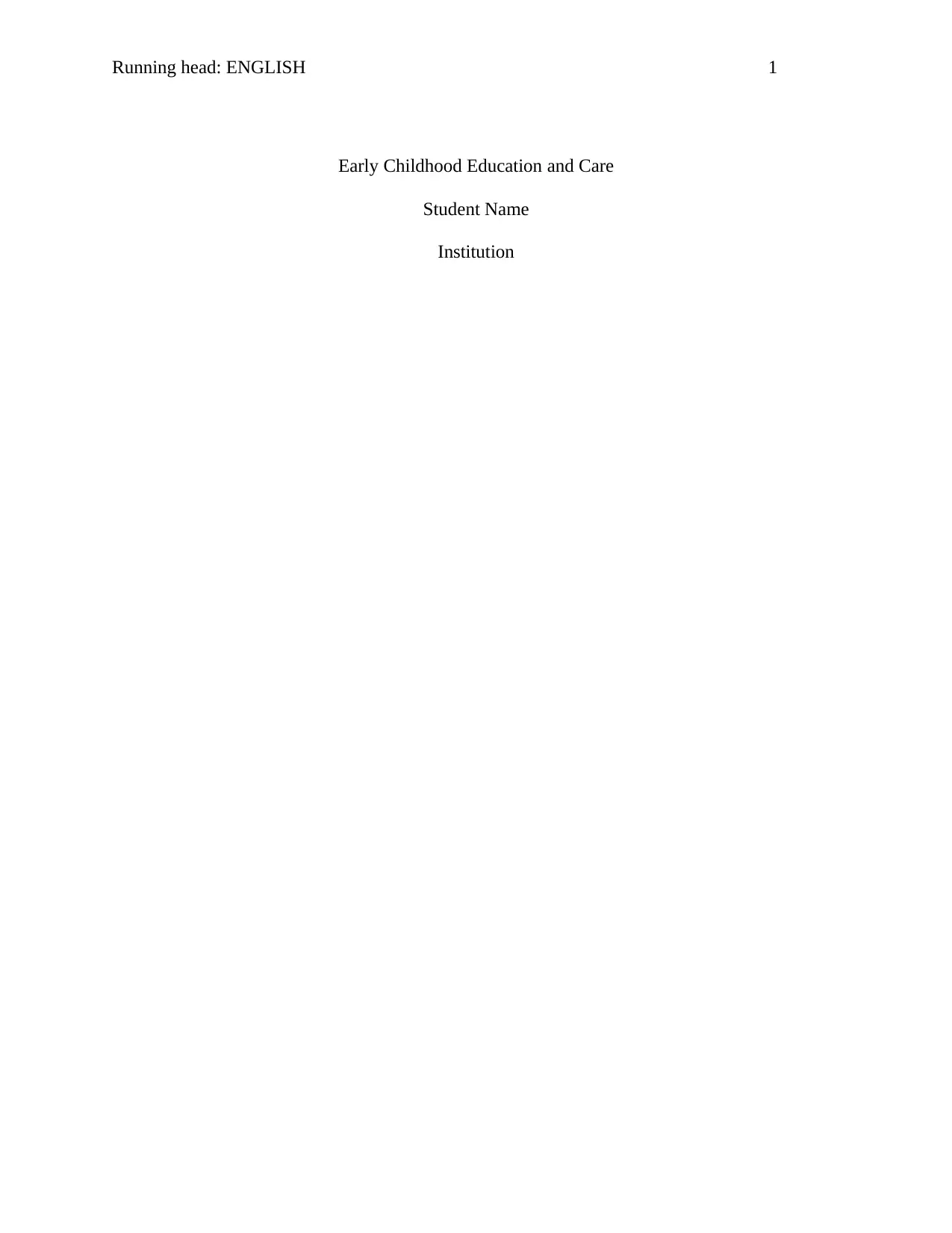
Running head: ENGLISH 1
Early Childhood Education and Care
Student Name
Institution
Early Childhood Education and Care
Student Name
Institution
Paraphrase This Document
Need a fresh take? Get an instant paraphrase of this document with our AI Paraphraser

ENGLISH 2
Executive summary
The paper focus on curriculum approach and documentation methods that is appropriate
for early childhood education and care. The paper identifies jottings and anecdotal records as the
two documentation methods used in early childhood education. Furthermore, the paper also
identifies developmentally appropriate practice and project approach as two curriculum approach
good for early childhood education and care. The relationship between documentation methods,
curriculum methods and early childhood education or care is also expounded in the paper. Some
theories and philosophies of education such as cognitivism, constructivism, behaviourism and
connectivism are also explored with their relation to both documentation methods and
curriculum approaches. The paper critiques various documentation methods and curriculum
approaches citing their effectiveness when used in early childhood education and care. The paper
conclude by identifying the importance of documentation methods and curriculum approaches
when used to provide early childhood education and care.
Executive summary
The paper focus on curriculum approach and documentation methods that is appropriate
for early childhood education and care. The paper identifies jottings and anecdotal records as the
two documentation methods used in early childhood education. Furthermore, the paper also
identifies developmentally appropriate practice and project approach as two curriculum approach
good for early childhood education and care. The relationship between documentation methods,
curriculum methods and early childhood education or care is also expounded in the paper. Some
theories and philosophies of education such as cognitivism, constructivism, behaviourism and
connectivism are also explored with their relation to both documentation methods and
curriculum approaches. The paper critiques various documentation methods and curriculum
approaches citing their effectiveness when used in early childhood education and care. The paper
conclude by identifying the importance of documentation methods and curriculum approaches
when used to provide early childhood education and care.
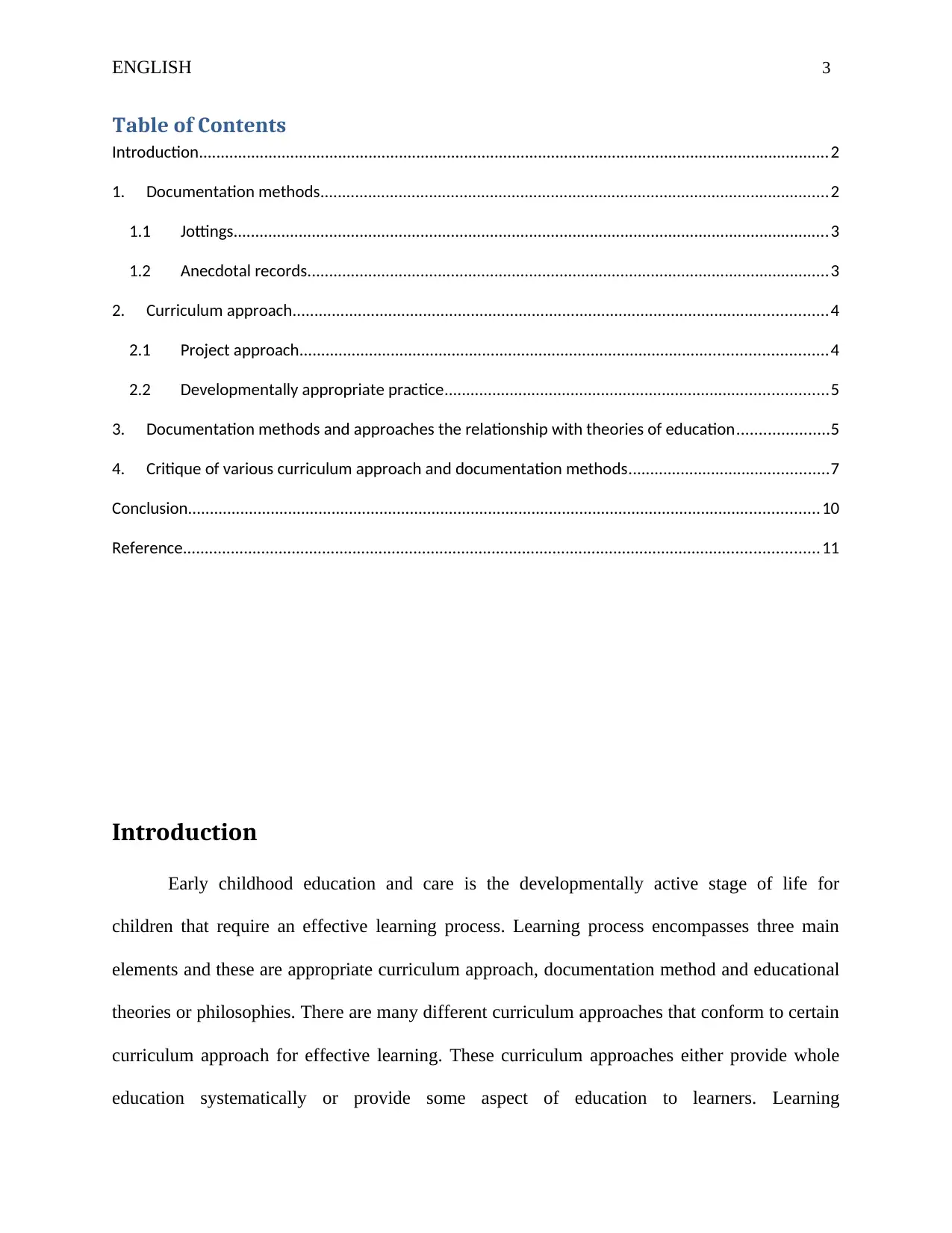
ENGLISH 3
Table of Contents
Introduction.................................................................................................................................................2
1. Documentation methods.....................................................................................................................2
1.1 Jottings.........................................................................................................................................3
1.2 Anecdotal records........................................................................................................................3
2. Curriculum approach...........................................................................................................................4
2.1 Project approach.........................................................................................................................4
2.2 Developmentally appropriate practice........................................................................................5
3. Documentation methods and approaches the relationship with theories of education.....................5
4. Critique of various curriculum approach and documentation methods..............................................7
Conclusion.................................................................................................................................................10
Reference..................................................................................................................................................11
Introduction
Early childhood education and care is the developmentally active stage of life for
children that require an effective learning process. Learning process encompasses three main
elements and these are appropriate curriculum approach, documentation method and educational
theories or philosophies. There are many different curriculum approaches that conform to certain
curriculum approach for effective learning. These curriculum approaches either provide whole
education systematically or provide some aspect of education to learners. Learning
Table of Contents
Introduction.................................................................................................................................................2
1. Documentation methods.....................................................................................................................2
1.1 Jottings.........................................................................................................................................3
1.2 Anecdotal records........................................................................................................................3
2. Curriculum approach...........................................................................................................................4
2.1 Project approach.........................................................................................................................4
2.2 Developmentally appropriate practice........................................................................................5
3. Documentation methods and approaches the relationship with theories of education.....................5
4. Critique of various curriculum approach and documentation methods..............................................7
Conclusion.................................................................................................................................................10
Reference..................................................................................................................................................11
Introduction
Early childhood education and care is the developmentally active stage of life for
children that require an effective learning process. Learning process encompasses three main
elements and these are appropriate curriculum approach, documentation method and educational
theories or philosophies. There are many different curriculum approaches that conform to certain
curriculum approach for effective learning. These curriculum approaches either provide whole
education systematically or provide some aspect of education to learners. Learning
⊘ This is a preview!⊘
Do you want full access?
Subscribe today to unlock all pages.

Trusted by 1+ million students worldwide

ENGLISH 4
documentation, on the other hand, can either record a detailed account of child learning progress
or record short account of learning progress. Analysis of these documentation methods alongside
the curriculum approaches is important for effective early childhood education and care. The
following paper there identifies two documentation methods and two curriculums approach that
effective in early childhood education and care.
1. Documentation methods
Documentation methods are important for recording of account of child experience, skills
or behaviours as observed during early childhood education and care. There are many different
documentation methods that are used for recording or to document learning process of children.
These documentation methods differs based ways records or entries are made and the type of
information that is captured.
1.1 Jottings
Jotting documentation method is an important documentation method when used in early
childhood education and care. The documentation approach involves taking shot notes on child's
progress developmental and behaviour. The documentation is done through four entries at each
developmental milestone throughout the learning process of a child and care (Nilsen, 2017).
When using jottings three aspects are contained within the jottings and these are behaviour/skill
or learning aspect, the developmental stage and the theoretical linkage to the behaviour or skill.
The documentation method is advantageous since it not time-consuming as compared to other
documentation methods. Moreover, jottings are used when a child is playing that forms aspect
early childhood learning process and also gives developmental milestones of a child (Yasseri,
Finley, Mayfield, Davis, Thompson & Vogler, 2018).
documentation, on the other hand, can either record a detailed account of child learning progress
or record short account of learning progress. Analysis of these documentation methods alongside
the curriculum approaches is important for effective early childhood education and care. The
following paper there identifies two documentation methods and two curriculums approach that
effective in early childhood education and care.
1. Documentation methods
Documentation methods are important for recording of account of child experience, skills
or behaviours as observed during early childhood education and care. There are many different
documentation methods that are used for recording or to document learning process of children.
These documentation methods differs based ways records or entries are made and the type of
information that is captured.
1.1 Jottings
Jotting documentation method is an important documentation method when used in early
childhood education and care. The documentation approach involves taking shot notes on child's
progress developmental and behaviour. The documentation is done through four entries at each
developmental milestone throughout the learning process of a child and care (Nilsen, 2017).
When using jottings three aspects are contained within the jottings and these are behaviour/skill
or learning aspect, the developmental stage and the theoretical linkage to the behaviour or skill.
The documentation method is advantageous since it not time-consuming as compared to other
documentation methods. Moreover, jottings are used when a child is playing that forms aspect
early childhood learning process and also gives developmental milestones of a child (Yasseri,
Finley, Mayfield, Davis, Thompson & Vogler, 2018).
Paraphrase This Document
Need a fresh take? Get an instant paraphrase of this document with our AI Paraphraser
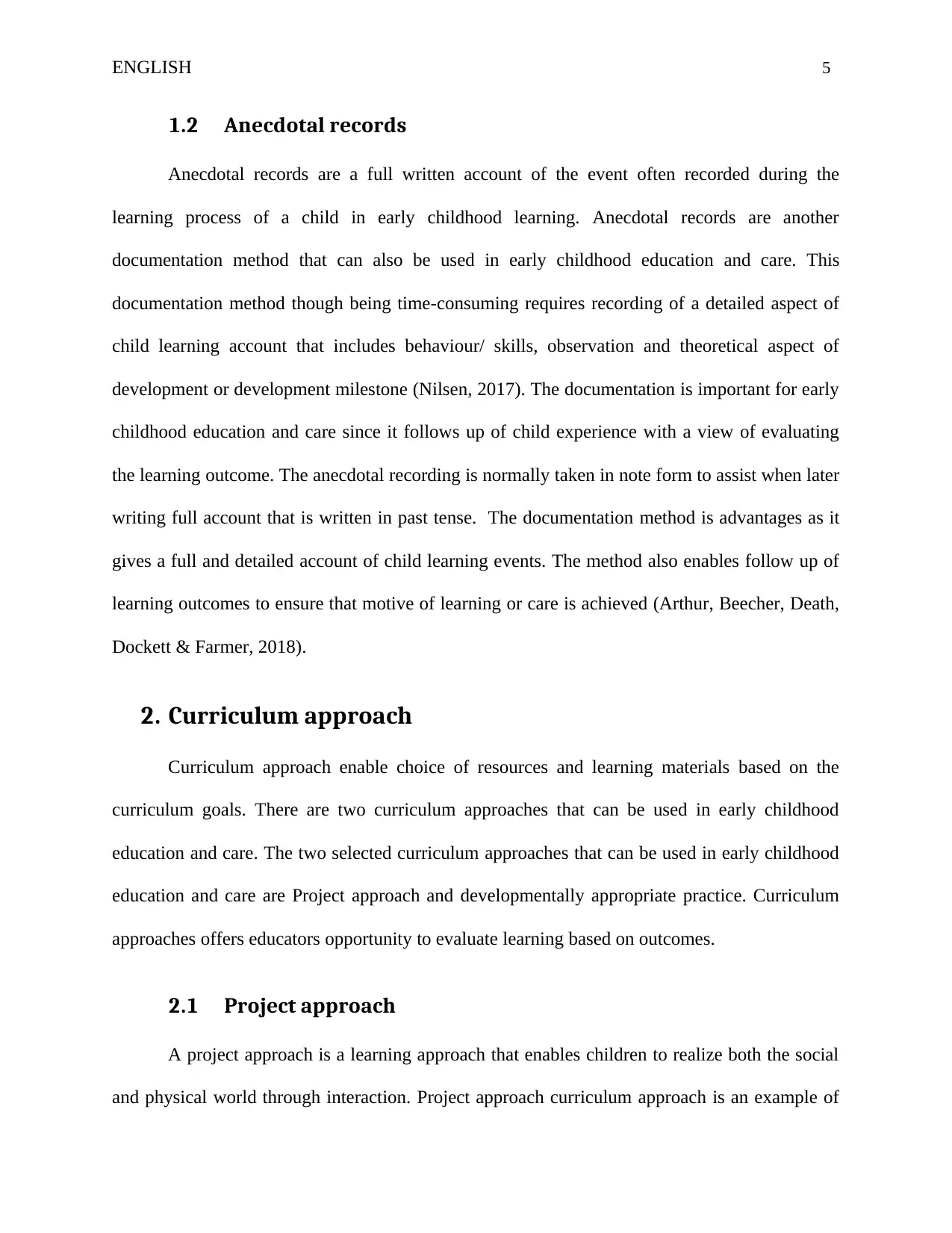
ENGLISH 5
1.2 Anecdotal records
Anecdotal records are a full written account of the event often recorded during the
learning process of a child in early childhood learning. Anecdotal records are another
documentation method that can also be used in early childhood education and care. This
documentation method though being time-consuming requires recording of a detailed aspect of
child learning account that includes behaviour/ skills, observation and theoretical aspect of
development or development milestone (Nilsen, 2017). The documentation is important for early
childhood education and care since it follows up of child experience with a view of evaluating
the learning outcome. The anecdotal recording is normally taken in note form to assist when later
writing full account that is written in past tense. The documentation method is advantages as it
gives a full and detailed account of child learning events. The method also enables follow up of
learning outcomes to ensure that motive of learning or care is achieved (Arthur, Beecher, Death,
Dockett & Farmer, 2018).
2. Curriculum approach
Curriculum approach enable choice of resources and learning materials based on the
curriculum goals. There are two curriculum approaches that can be used in early childhood
education and care. The two selected curriculum approaches that can be used in early childhood
education and care are Project approach and developmentally appropriate practice. Curriculum
approaches offers educators opportunity to evaluate learning based on outcomes.
2.1 Project approach
A project approach is a learning approach that enables children to realize both the social
and physical world through interaction. Project approach curriculum approach is an example of
1.2 Anecdotal records
Anecdotal records are a full written account of the event often recorded during the
learning process of a child in early childhood learning. Anecdotal records are another
documentation method that can also be used in early childhood education and care. This
documentation method though being time-consuming requires recording of a detailed aspect of
child learning account that includes behaviour/ skills, observation and theoretical aspect of
development or development milestone (Nilsen, 2017). The documentation is important for early
childhood education and care since it follows up of child experience with a view of evaluating
the learning outcome. The anecdotal recording is normally taken in note form to assist when later
writing full account that is written in past tense. The documentation method is advantages as it
gives a full and detailed account of child learning events. The method also enables follow up of
learning outcomes to ensure that motive of learning or care is achieved (Arthur, Beecher, Death,
Dockett & Farmer, 2018).
2. Curriculum approach
Curriculum approach enable choice of resources and learning materials based on the
curriculum goals. There are two curriculum approaches that can be used in early childhood
education and care. The two selected curriculum approaches that can be used in early childhood
education and care are Project approach and developmentally appropriate practice. Curriculum
approaches offers educators opportunity to evaluate learning based on outcomes.
2.1 Project approach
A project approach is a learning approach that enables children to realize both the social
and physical world through interaction. Project approach curriculum approach is an example of

ENGLISH 6
an approach that can be used to realize a child-centred early childhood education and care. The
approach is important since it enables students to interact and share the experience of real-world
(Knoll, 2014). This is important for training children to take advantage of the social aspect of
schooling for better early childhood development. The approach also allows children to make
decision and choices through collaborative learning within small groups. This curriculum
approach enables detailed study of children's interaction based on real-world topics. Moreover,
the project approach is often used alongside the whole education curriculum approach as it
provides specific learn peculiar to learners (Heick, 2013).
2.2 Developmentally appropriate practice
The developmentally appropriate practice is a curriculum approach that focuses on early
childhood development as a critical aspect of education and care. This implies that the approach
takes advantage of various developmental stages of the child to foster education and care. In
addition, the approach considers the mental, physical and emotional development of the child as
a recipe for moving from simple to complex education training. This approach also considers
various resources and materials that are important at a particular age. Therefore, learning and
care are fashioned according to the age of a child. The developmentally appropriate practice is
normally used by many countries as a standard curriculum that can be used to provide whole
systematic education and care (Machado, 2015).
3. Documentation methods and approaches the relationship
with theories of education
Jottings documentation methods is an example of documentation methods that are related
to behaviourism educational philosophy that is used to record a child’s behaviour. Jottings
an approach that can be used to realize a child-centred early childhood education and care. The
approach is important since it enables students to interact and share the experience of real-world
(Knoll, 2014). This is important for training children to take advantage of the social aspect of
schooling for better early childhood development. The approach also allows children to make
decision and choices through collaborative learning within small groups. This curriculum
approach enables detailed study of children's interaction based on real-world topics. Moreover,
the project approach is often used alongside the whole education curriculum approach as it
provides specific learn peculiar to learners (Heick, 2013).
2.2 Developmentally appropriate practice
The developmentally appropriate practice is a curriculum approach that focuses on early
childhood development as a critical aspect of education and care. This implies that the approach
takes advantage of various developmental stages of the child to foster education and care. In
addition, the approach considers the mental, physical and emotional development of the child as
a recipe for moving from simple to complex education training. This approach also considers
various resources and materials that are important at a particular age. Therefore, learning and
care are fashioned according to the age of a child. The developmentally appropriate practice is
normally used by many countries as a standard curriculum that can be used to provide whole
systematic education and care (Machado, 2015).
3. Documentation methods and approaches the relationship
with theories of education
Jottings documentation methods is an example of documentation methods that are related
to behaviourism educational philosophy that is used to record a child’s behaviour. Jottings
⊘ This is a preview!⊘
Do you want full access?
Subscribe today to unlock all pages.

Trusted by 1+ million students worldwide
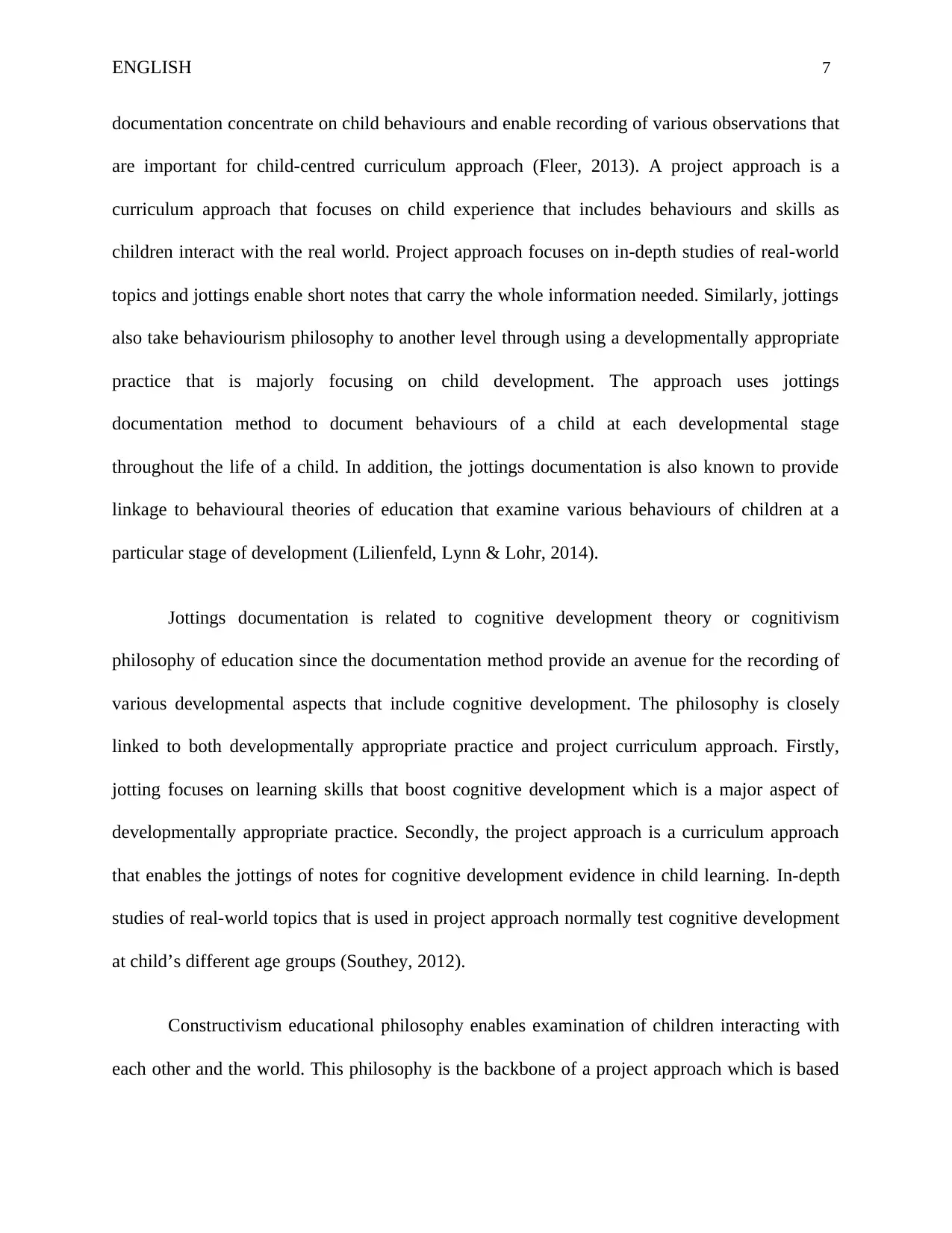
ENGLISH 7
documentation concentrate on child behaviours and enable recording of various observations that
are important for child-centred curriculum approach (Fleer, 2013). A project approach is a
curriculum approach that focuses on child experience that includes behaviours and skills as
children interact with the real world. Project approach focuses on in-depth studies of real-world
topics and jottings enable short notes that carry the whole information needed. Similarly, jottings
also take behaviourism philosophy to another level through using a developmentally appropriate
practice that is majorly focusing on child development. The approach uses jottings
documentation method to document behaviours of a child at each developmental stage
throughout the life of a child. In addition, the jottings documentation is also known to provide
linkage to behavioural theories of education that examine various behaviours of children at a
particular stage of development (Lilienfeld, Lynn & Lohr, 2014).
Jottings documentation is related to cognitive development theory or cognitivism
philosophy of education since the documentation method provide an avenue for the recording of
various developmental aspects that include cognitive development. The philosophy is closely
linked to both developmentally appropriate practice and project curriculum approach. Firstly,
jotting focuses on learning skills that boost cognitive development which is a major aspect of
developmentally appropriate practice. Secondly, the project approach is a curriculum approach
that enables the jottings of notes for cognitive development evidence in child learning. In-depth
studies of real-world topics that is used in project approach normally test cognitive development
at child’s different age groups (Southey, 2012).
Constructivism educational philosophy enables examination of children interacting with
each other and the world. This philosophy is the backbone of a project approach which is based
documentation concentrate on child behaviours and enable recording of various observations that
are important for child-centred curriculum approach (Fleer, 2013). A project approach is a
curriculum approach that focuses on child experience that includes behaviours and skills as
children interact with the real world. Project approach focuses on in-depth studies of real-world
topics and jottings enable short notes that carry the whole information needed. Similarly, jottings
also take behaviourism philosophy to another level through using a developmentally appropriate
practice that is majorly focusing on child development. The approach uses jottings
documentation method to document behaviours of a child at each developmental stage
throughout the life of a child. In addition, the jottings documentation is also known to provide
linkage to behavioural theories of education that examine various behaviours of children at a
particular stage of development (Lilienfeld, Lynn & Lohr, 2014).
Jottings documentation is related to cognitive development theory or cognitivism
philosophy of education since the documentation method provide an avenue for the recording of
various developmental aspects that include cognitive development. The philosophy is closely
linked to both developmentally appropriate practice and project curriculum approach. Firstly,
jotting focuses on learning skills that boost cognitive development which is a major aspect of
developmentally appropriate practice. Secondly, the project approach is a curriculum approach
that enables the jottings of notes for cognitive development evidence in child learning. In-depth
studies of real-world topics that is used in project approach normally test cognitive development
at child’s different age groups (Southey, 2012).
Constructivism educational philosophy enables examination of children interacting with
each other and the world. This philosophy is the backbone of a project approach which is based
Paraphrase This Document
Need a fresh take? Get an instant paraphrase of this document with our AI Paraphraser

ENGLISH 8
on children interaction and perception of the real world. The interaction between children is
documented through anecdotal records. The anecdotal records enable documentation of full
account of the child's observed skills or behaviours are they interact in learning. Constructivism
philosophy also spelt out the critical aspect of developmental appropriate approach that is also
designed to focus on child experience, resources and materials. The developmental appropriate
practice is known for a learning experience at different ages which require anecdotal
documentation to keep a full record. Anecdotal records offer full information regarding child
development throughout developmental stages (Nolan & Raban, 2015).
Connectivism is another education philosophy that takes into account interconnections
within the learning process. This connectivism is key for in-depth studies of real-world topics as
applied in the project approach. However, connectivism requires deeper documentation of
account of the experience that is offered by the anecdotal records. Jottings, on the other hand,
provide short notes that remain limited when understanding interconnection in a learning
environment. Connectivism philosophy is essential for interconnecting two curriculum
approaches of the project approach and developmentally appropriate practice (Beloglovsky &
Daly, 2015).
4. Critique of various curriculum approach and
documentation methods
Jottings documentation method is an important education documentation that enables
recording of child educational experience. An examination of using jottings shows that jottings
have effectiveness and disadvantages. Firstly, using jottings enable writing of short notes that are
directed towards the developmental aspect of the child. This documentation method is effective
on children interaction and perception of the real world. The interaction between children is
documented through anecdotal records. The anecdotal records enable documentation of full
account of the child's observed skills or behaviours are they interact in learning. Constructivism
philosophy also spelt out the critical aspect of developmental appropriate approach that is also
designed to focus on child experience, resources and materials. The developmental appropriate
practice is known for a learning experience at different ages which require anecdotal
documentation to keep a full record. Anecdotal records offer full information regarding child
development throughout developmental stages (Nolan & Raban, 2015).
Connectivism is another education philosophy that takes into account interconnections
within the learning process. This connectivism is key for in-depth studies of real-world topics as
applied in the project approach. However, connectivism requires deeper documentation of
account of the experience that is offered by the anecdotal records. Jottings, on the other hand,
provide short notes that remain limited when understanding interconnection in a learning
environment. Connectivism philosophy is essential for interconnecting two curriculum
approaches of the project approach and developmentally appropriate practice (Beloglovsky &
Daly, 2015).
4. Critique of various curriculum approach and
documentation methods
Jottings documentation method is an important education documentation that enables
recording of child educational experience. An examination of using jottings shows that jottings
have effectiveness and disadvantages. Firstly, using jottings enable writing of short notes that are
directed towards the developmental aspect of the child. This documentation method is effective

ENGLISH 9
for faster and less time note-taking during children learning experience (Nilsen, 2017). This
remains an important aspect of the documentation method as critical, especially where there are
few educators to collect information on the progress of children. This can also be dangerous
when important information is left outside when making short notes. But still, jottings enable
faster recording of information when some event such as when children are playing and faster
information recording is required. However, the documentation method is also less effective
when it comes to recording more information and this also acts as the disadvantage of the
documentation method. Secondly, jottings are less effective when are used to take notes that
require a detailed account of child experience. Jottings are less effective since many
developmental stages require detailed information to give education evaluation on the outcome
(Perrault & Albert, 2017).
Anecdotal records are known to give a detailed account of child behaviour, learning skills
and experience with challenges. Anecdotal records is another documentation method that can be
analyzed based on its effectiveness. Anecdotal records are, however, less effective in a number
of ways and this includes time-consuming (PSC National Alliance, 2012). Though anecdotal has
short notes before writing a full account of the experience, the anecdotal records are prone to
time-consuming and often require short note which is then written in details. In addition, quality
of the anecdotal records depends on the person doing the observation since the observation are
done and short notes written with detail later based on the memory of the observer. Usage of
anecdotal records is downplayed by its room for biasness. Anecdotal records offer the
opportunity for biasness since the observer on record what interest the observer. When an
observer is taking account of child behaviour, an incident occurring at that time may be taken out
for faster and less time note-taking during children learning experience (Nilsen, 2017). This
remains an important aspect of the documentation method as critical, especially where there are
few educators to collect information on the progress of children. This can also be dangerous
when important information is left outside when making short notes. But still, jottings enable
faster recording of information when some event such as when children are playing and faster
information recording is required. However, the documentation method is also less effective
when it comes to recording more information and this also acts as the disadvantage of the
documentation method. Secondly, jottings are less effective when are used to take notes that
require a detailed account of child experience. Jottings are less effective since many
developmental stages require detailed information to give education evaluation on the outcome
(Perrault & Albert, 2017).
Anecdotal records are known to give a detailed account of child behaviour, learning skills
and experience with challenges. Anecdotal records is another documentation method that can be
analyzed based on its effectiveness. Anecdotal records are, however, less effective in a number
of ways and this includes time-consuming (PSC National Alliance, 2012). Though anecdotal has
short notes before writing a full account of the experience, the anecdotal records are prone to
time-consuming and often require short note which is then written in details. In addition, quality
of the anecdotal records depends on the person doing the observation since the observation are
done and short notes written with detail later based on the memory of the observer. Usage of
anecdotal records is downplayed by its room for biasness. Anecdotal records offer the
opportunity for biasness since the observer on record what interest the observer. When an
observer is taking account of child behaviour, an incident occurring at that time may be taken out
⊘ This is a preview!⊘
Do you want full access?
Subscribe today to unlock all pages.

Trusted by 1+ million students worldwide
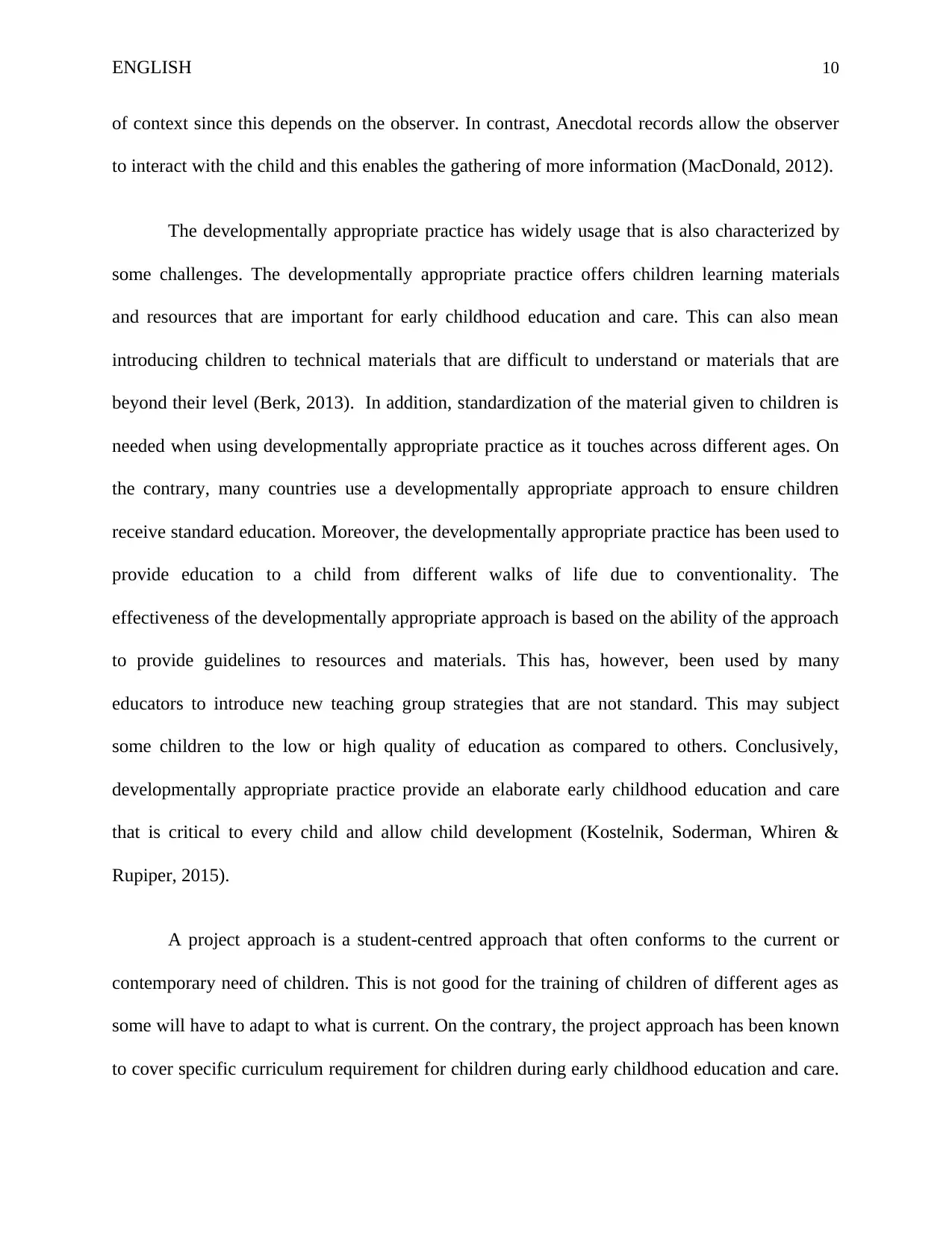
ENGLISH 10
of context since this depends on the observer. In contrast, Anecdotal records allow the observer
to interact with the child and this enables the gathering of more information (MacDonald, 2012).
The developmentally appropriate practice has widely usage that is also characterized by
some challenges. The developmentally appropriate practice offers children learning materials
and resources that are important for early childhood education and care. This can also mean
introducing children to technical materials that are difficult to understand or materials that are
beyond their level (Berk, 2013). In addition, standardization of the material given to children is
needed when using developmentally appropriate practice as it touches across different ages. On
the contrary, many countries use a developmentally appropriate approach to ensure children
receive standard education. Moreover, the developmentally appropriate practice has been used to
provide education to a child from different walks of life due to conventionality. The
effectiveness of the developmentally appropriate approach is based on the ability of the approach
to provide guidelines to resources and materials. This has, however, been used by many
educators to introduce new teaching group strategies that are not standard. This may subject
some children to the low or high quality of education as compared to others. Conclusively,
developmentally appropriate practice provide an elaborate early childhood education and care
that is critical to every child and allow child development (Kostelnik, Soderman, Whiren &
Rupiper, 2015).
A project approach is a student-centred approach that often conforms to the current or
contemporary need of children. This is not good for the training of children of different ages as
some will have to adapt to what is current. On the contrary, the project approach has been known
to cover specific curriculum requirement for children during early childhood education and care.
of context since this depends on the observer. In contrast, Anecdotal records allow the observer
to interact with the child and this enables the gathering of more information (MacDonald, 2012).
The developmentally appropriate practice has widely usage that is also characterized by
some challenges. The developmentally appropriate practice offers children learning materials
and resources that are important for early childhood education and care. This can also mean
introducing children to technical materials that are difficult to understand or materials that are
beyond their level (Berk, 2013). In addition, standardization of the material given to children is
needed when using developmentally appropriate practice as it touches across different ages. On
the contrary, many countries use a developmentally appropriate approach to ensure children
receive standard education. Moreover, the developmentally appropriate practice has been used to
provide education to a child from different walks of life due to conventionality. The
effectiveness of the developmentally appropriate approach is based on the ability of the approach
to provide guidelines to resources and materials. This has, however, been used by many
educators to introduce new teaching group strategies that are not standard. This may subject
some children to the low or high quality of education as compared to others. Conclusively,
developmentally appropriate practice provide an elaborate early childhood education and care
that is critical to every child and allow child development (Kostelnik, Soderman, Whiren &
Rupiper, 2015).
A project approach is a student-centred approach that often conforms to the current or
contemporary need of children. This is not good for the training of children of different ages as
some will have to adapt to what is current. On the contrary, the project approach has been known
to cover specific curriculum requirement for children during early childhood education and care.
Paraphrase This Document
Need a fresh take? Get an instant paraphrase of this document with our AI Paraphraser
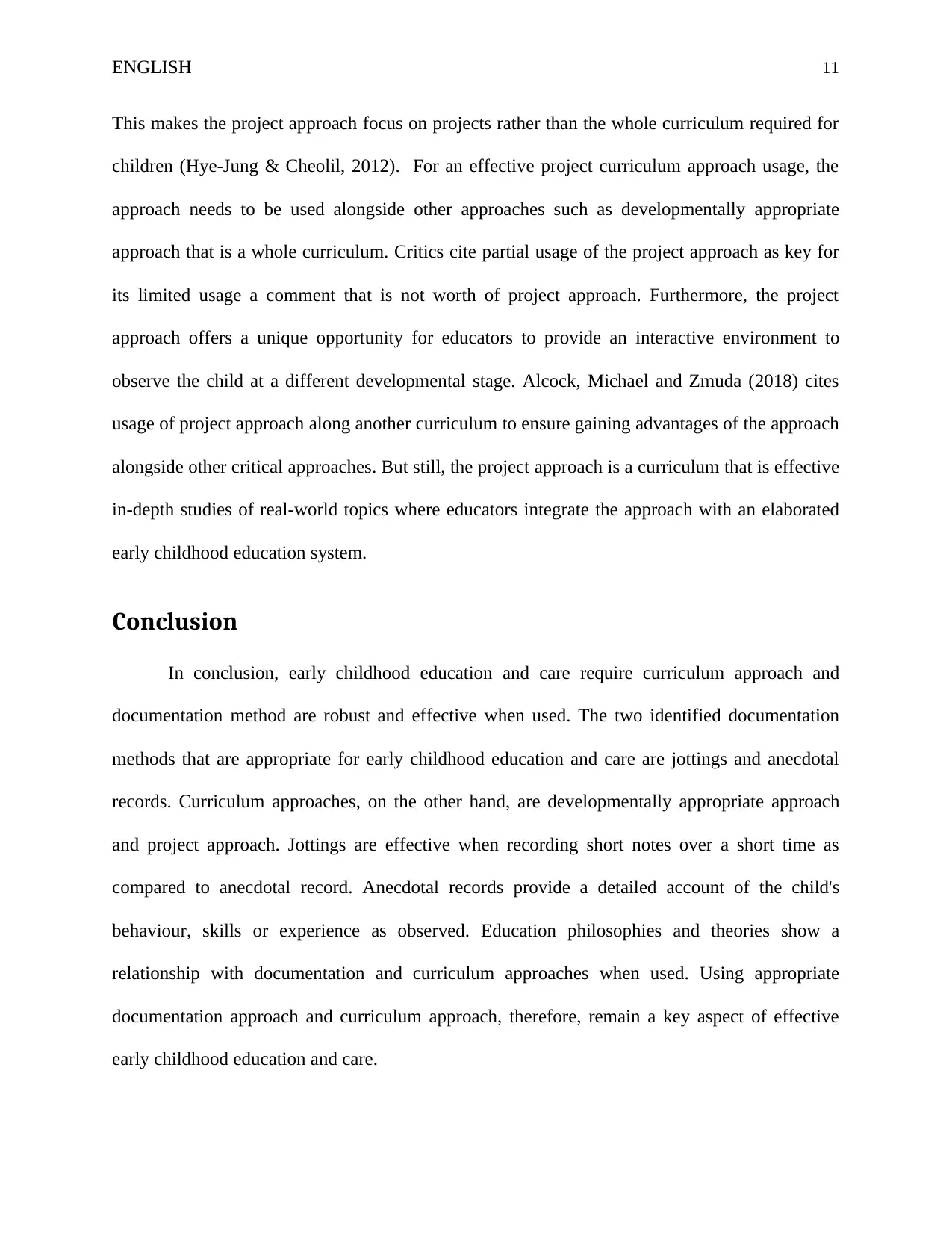
ENGLISH 11
This makes the project approach focus on projects rather than the whole curriculum required for
children (Hye-Jung & Cheolil, 2012). For an effective project curriculum approach usage, the
approach needs to be used alongside other approaches such as developmentally appropriate
approach that is a whole curriculum. Critics cite partial usage of the project approach as key for
its limited usage a comment that is not worth of project approach. Furthermore, the project
approach offers a unique opportunity for educators to provide an interactive environment to
observe the child at a different developmental stage. Alcock, Michael and Zmuda (2018) cites
usage of project approach along another curriculum to ensure gaining advantages of the approach
alongside other critical approaches. But still, the project approach is a curriculum that is effective
in-depth studies of real-world topics where educators integrate the approach with an elaborated
early childhood education system.
Conclusion
In conclusion, early childhood education and care require curriculum approach and
documentation method are robust and effective when used. The two identified documentation
methods that are appropriate for early childhood education and care are jottings and anecdotal
records. Curriculum approaches, on the other hand, are developmentally appropriate approach
and project approach. Jottings are effective when recording short notes over a short time as
compared to anecdotal record. Anecdotal records provide a detailed account of the child's
behaviour, skills or experience as observed. Education philosophies and theories show a
relationship with documentation and curriculum approaches when used. Using appropriate
documentation approach and curriculum approach, therefore, remain a key aspect of effective
early childhood education and care.
This makes the project approach focus on projects rather than the whole curriculum required for
children (Hye-Jung & Cheolil, 2012). For an effective project curriculum approach usage, the
approach needs to be used alongside other approaches such as developmentally appropriate
approach that is a whole curriculum. Critics cite partial usage of the project approach as key for
its limited usage a comment that is not worth of project approach. Furthermore, the project
approach offers a unique opportunity for educators to provide an interactive environment to
observe the child at a different developmental stage. Alcock, Michael and Zmuda (2018) cites
usage of project approach along another curriculum to ensure gaining advantages of the approach
alongside other critical approaches. But still, the project approach is a curriculum that is effective
in-depth studies of real-world topics where educators integrate the approach with an elaborated
early childhood education system.
Conclusion
In conclusion, early childhood education and care require curriculum approach and
documentation method are robust and effective when used. The two identified documentation
methods that are appropriate for early childhood education and care are jottings and anecdotal
records. Curriculum approaches, on the other hand, are developmentally appropriate approach
and project approach. Jottings are effective when recording short notes over a short time as
compared to anecdotal record. Anecdotal records provide a detailed account of the child's
behaviour, skills or experience as observed. Education philosophies and theories show a
relationship with documentation and curriculum approaches when used. Using appropriate
documentation approach and curriculum approach, therefore, remain a key aspect of effective
early childhood education and care.

ENGLISH 12
Reference
Alcock, M., Michael, F. & Zmuda, A. (2018). The Quest for Learning: How to Maximize Student
Engagement. Bloomington: Solution Tree. Retrieved from
https://www.solutiontree.com/quest-for-learning.html
Arthur, L., Beecher, B., Death, E., Dockett, S., & Farmer, S. (2018). Programming and planning
in early childhood settings (7th ed.). Melbourne, VIC: Cengage Learning Australia.
(Chapter 7).
Berk, L. (2013). Child development (9th ed.). USA: Pearson Education. (Chapter 2).
Beloglovsky, M. & Daly, L. (2015). Early Learning Theories Made Visibly. Redleaf Press, Saint
Paul, United States.
Fleer, M. (2013). Play in the early years. Australia: Cambridge University Press
Reference
Alcock, M., Michael, F. & Zmuda, A. (2018). The Quest for Learning: How to Maximize Student
Engagement. Bloomington: Solution Tree. Retrieved from
https://www.solutiontree.com/quest-for-learning.html
Arthur, L., Beecher, B., Death, E., Dockett, S., & Farmer, S. (2018). Programming and planning
in early childhood settings (7th ed.). Melbourne, VIC: Cengage Learning Australia.
(Chapter 7).
Berk, L. (2013). Child development (9th ed.). USA: Pearson Education. (Chapter 2).
Beloglovsky, M. & Daly, L. (2015). Early Learning Theories Made Visibly. Redleaf Press, Saint
Paul, United States.
Fleer, M. (2013). Play in the early years. Australia: Cambridge University Press
⊘ This is a preview!⊘
Do you want full access?
Subscribe today to unlock all pages.

Trusted by 1+ million students worldwide
1 out of 15
Related Documents
Your All-in-One AI-Powered Toolkit for Academic Success.
+13062052269
info@desklib.com
Available 24*7 on WhatsApp / Email
![[object Object]](/_next/static/media/star-bottom.7253800d.svg)
Unlock your academic potential
Copyright © 2020–2025 A2Z Services. All Rights Reserved. Developed and managed by ZUCOL.





